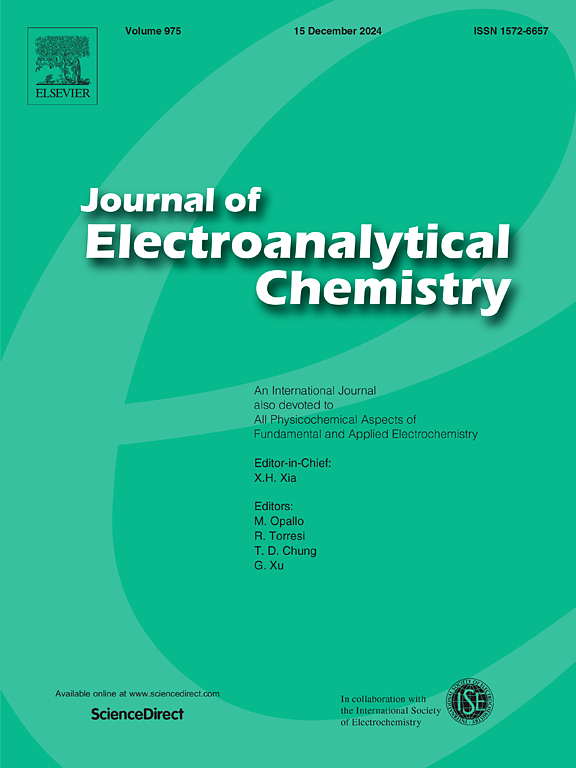Engineered controlled on the synthesis of bismuth-molybdenum oxide semiconductors tailors photoelectrocatalytic activity
IF 4.1
3区 化学
Q1 CHEMISTRY, ANALYTICAL
引用次数: 0
Abstract
The engineered fabrication of Bi2MoO6 thin-films enables controlled modification of photoelectrocatalytic responses based on the synthesis method. Using a modified Pechini auto-combustion method, which involves the formation of stable chelates between mixed metal ions and citric acid, the photoelectrochemical performance of Bi2MoO6 can be tuned by varying the synthesis components. This study elucidates the impacts of HNO3, NH3, and Bi3+ concentrations during the manufacturing of Bi2MoO6 thin layers. The concentration of HNO3 was critical for the formation of a high-purity crystallographic phase. Adding NH3 enhanced photoelectrochemical responses due to its thermal effect during combustion, resulting from crosslinking between metal-citrate complexes. Additionally, the photocurrent response under applied potential and light irradiation (λ = 365 nm) could be tuned by adjusting the stoichiometry between Bi3+ and Mo6+. The optimal Bi3+:Mo6+ ratio resulted in the maximum photocurrent of 0.65 mA cm-2 at 0.61 V vs Ag/AgCl (1.23 V vs RHE) and lowest charge transfer resistance value of 0.8 kΩ when evaluated in the presence of hole-scavenger species. This study provides an understanding into the role of each synthesis component and highlights the importance of optimizing synthesis procedures to achieve higher photoelectrochemical performance in thin-film catalysts.
通过对 Bi2MoO6 薄膜进行工程化制造,可以根据合成方法对光电催化反应进行可控修改。使用改良的 Pechini 自燃法(该方法涉及混合金属离子与柠檬酸之间形成稳定的螯合物),可以通过改变合成成分来调整 Bi2MoO6 的光电化学性能。本研究阐明了在制造 Bi2MoO6 薄层过程中 HNO3、NH3 和 Bi3+ 浓度的影响。HNO3 的浓度对形成高纯度结晶相至关重要。添加 NH3 可增强光电化学反应,这是因为 NH3 在燃烧过程中会产生热效应,导致金属-柠檬酸盐复合物之间发生交联。此外,还可以通过调整 Bi3+ 和 Mo6+ 之间的配比来调整外加电位和光照射(λ = 365 纳米)下的光电流响应。最佳的 Bi3+:Mo6+ 比率可在 0.61 V 对 Ag/AgCl(1.23 V 对 RHE)条件下产生 0.65 mA cm-2 的最大光电流,在有空穴清除剂存在的情况下,电荷转移电阻值最低,为 0.8 kΩ。这项研究让人们了解了每种合成成分的作用,并强调了优化合成程序以提高薄膜催化剂光电化学性能的重要性。
本文章由计算机程序翻译,如有差异,请以英文原文为准。
求助全文
约1分钟内获得全文
求助全文
来源期刊
CiteScore
7.80
自引率
6.70%
发文量
912
审稿时长
2.4 months
期刊介绍:
The Journal of Electroanalytical Chemistry is the foremost international journal devoted to the interdisciplinary subject of electrochemistry in all its aspects, theoretical as well as applied.
Electrochemistry is a wide ranging area that is in a state of continuous evolution. Rather than compiling a long list of topics covered by the Journal, the editors would like to draw particular attention to the key issues of novelty, topicality and quality. Papers should present new and interesting electrochemical science in a way that is accessible to the reader. The presentation and discussion should be at a level that is consistent with the international status of the Journal. Reports describing the application of well-established techniques to problems that are essentially technical will not be accepted. Similarly, papers that report observations but fail to provide adequate interpretation will be rejected by the Editors. Papers dealing with technical electrochemistry should be submitted to other specialist journals unless the authors can show that their work provides substantially new insights into electrochemical processes.

 求助内容:
求助内容: 应助结果提醒方式:
应助结果提醒方式:


